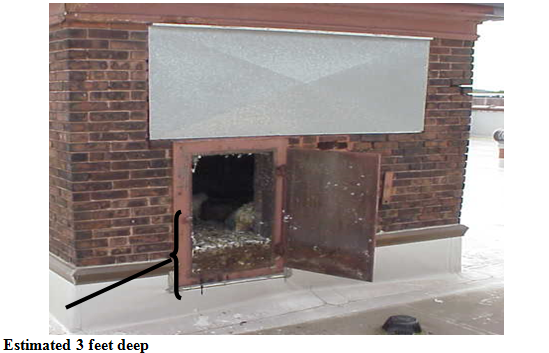Guidelines for the remediation of bird waste inside buildings

Buildings contaminated with bird wastes can pose health concerns to building occupants. The vent depicted in the picture appears to be the accumulation of bird wastes over a long period of time, resulting in an estimated volume of at least 300 cubic feet. The base of this vent is connected by ductwork to open vents in classrooms. In addition to presenting health concerns to building occupants, exposures to microorganisms in bird wastes can also result in health concerns for remediation workers. Thus, a 3 step approach is necessary to remediate accumulated bird waste:
- Protection of building occupants and systems (e.g., ventilation equipment)
- Disinfection of contaminated surfaces
- Protection of remediation workers from exposure during removal and cleaning operations.
Additional Resources
-
Open PDF file, 120.04 KB, Remediation of Bird Waste inside Buildings (English, PDF 120.04 KB)
-
Open DOCX file, 183.83 KB, Remediation of Bird Waste inside Buildings (English, DOCX 183.83 KB)
Disease associated with bird wastes
Mold is associated with bird waste. Exposures to bird wastes are thought to be associated with various diseases of the respiratory system, including the development of hypersensitivity pneumonitis in some individuals and psittacosis (bird fancier's disease) among those occupationally exposed or in a bird raising setting. While immune-compromised individuals have an increased risk to exposure to the materials in bird waste, these diseases may occur in healthy individuals exposed to these materials.
Clean up methods
The methods used in clean up of a bird waste problem depend on the amount of waste and the types of materials contaminated. In some cases, (e.g., the conditions shown in the picture) a professional cleaning contractor should conduct the clean-up of the bird wastes. In other cases where several droppings are involved, cleaning the contaminated material with a solution of sodium hypochlorite is an effective method (CDC, 1998). Disinfection of non-porous materials can be readily accomplished with this solution. Porous materials contaminated with bird waste should be examined by a professional restoration contractor to determine if the materials can be salvaged. Where a porous material has been colonized with mold, it is recommended that the material be discarded (ACGIH, 1989).
Building occupant/worker protection
During cleanup of bird wastes, it is important to prevent occupational exposures as well as prevent exposures to building occupants. Any individual using cleaning solutions is required to be trained to use personal protective equipment to prevent the spread of disease from the bird wastes and trained on the proper methods to prevent exposure to cleaning chemicals. Current Material Safety Data Sheets (MSDS) for all cleaning products used in remediating bird wastes must be acquired, in conformance with the Massachusetts Right-To-Know Law, M.G.L. c. 111F (MGL, 1983).
In addition, the method used to clean up bird wastes may result in aerosolization of particulates that can spread to occupied areas via openings (e.g., doors) or by the ventilation system. To prevent spread of aerosolized particulates, we would recommend that the individuals conducting cleanup use the methods listed in the SMACNA guidelines for Containment of Renovation in Occupied Buildings (SMACNA, 1995).
References
- ACGIH. 1989. Guidelines for the Assessment of Bioaerosols in the Indoor Environment. American Conference of Governmental Industrial Hygienists, Cincinnati, OH.
- CDC. 1998. Compendium of Measures to Control Chlamydia psittaci Infection Among Human (Psittacosis and Pet Birds (Avian Chlamydiosis), 1998. MMWR 47:RR-10. July 10, 1998.
- MGL. 1983. Hazardous Substances Disclosure by Employers. Massachusetts General Laws. M.G.L. c. 111F.
- SMACNA. 1995. IAQ Guidelines for Occupied Buildings Under Construction. 1st ed. Sheet Metal and Air Conditioning Contractors’ National Association, Inc., Chantilly, VA.